

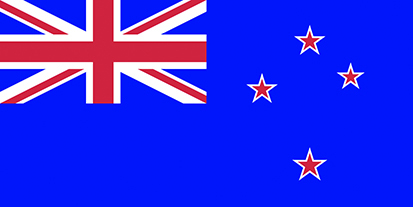 Wellington is the capital city and the second most populous city in New Zealand. The Port of Wellington is located on a natural scenic harbour with green hills surrounding Wellington Bay, which has tiered suburbs of colonial villas stretching up to the top of the nearby mountains. These include Mount Kaukau at 445 metres elevation, Mount Victoria at 196 metres, Mount Albert at 178 metres and Mount Alfred at 122 metres elevation. Mount Cook is named in honour of British explorer Capt. James Cook, who visited the area during three worldwide voyages of discovery in the 1770s, and is the name of both a nearby hill and a suburb of Wellington. Lambton Harbour, Lambton Quay and Clyde Quay Wharf are located on an arm of Wellington Bay, and are reached on arrival by a sharp turn to port around the Miramar peninsula.
Wellington is the capital city and the second most populous city in New Zealand. The Port of Wellington is located on a natural scenic harbour with green hills surrounding Wellington Bay, which has tiered suburbs of colonial villas stretching up to the top of the nearby mountains. These include Mount Kaukau at 445 metres elevation, Mount Victoria at 196 metres, Mount Albert at 178 metres and Mount Alfred at 122 metres elevation. Mount Cook is named in honour of British explorer Capt. James Cook, who visited the area during three worldwide voyages of discovery in the 1770s, and is the name of both a nearby hill and a suburb of Wellington. Lambton Harbour, Lambton Quay and Clyde Quay Wharf are located on an arm of Wellington Bay, and are reached on arrival by a sharp turn to port around the Miramar peninsula.
The outer harbour is reached through a small entrance from the Cook Strait between the North and South Islands. Wellington Bay has an area of sheltered waterway of 20,000 acres with an average depth of between seven and nine fathoms. The Port of Wellington is thus endowed with many natural advantages, and has grown to handle well over ten million tonnes of cargo per annum, as well as being a chief distribution centre. Dairy produce, wool, meat and fruit are important traffic as well as the newly developing industries in the Hutt valley including car assembly, rubber processing, and oil refineries.
History Of Wellington
Kupe, the great chief of the Hawaiki tribe of Maoris, arrived in the district in the year 1280 AD from the north and explored the whole area, giving the name Whanganui a Tara to the area. The Maoris are believed to have arrived in New Zealand from Polynesia between 1000 AD and 1200 AD, with the latter date as the more likely. European settlement began with the arrival of an advance party of the New Zealand Company on the sailing ship Tory on 20th September 1839, followed by 140 settlers on the Aurora on 22nd January 1840. The New Zealand Parliament met for the first time on a temporary basis at Wellington on 7th July 1862, becoming permanent on 26th July 1865. The merging of the many smaller boroughs in the district was begun in 1903, and Greater Metropolitan Wellington grew to a population of 114,950 people in 1935 spread over 24.5 square miles. The present population of Greater Metropolitan Wellington is now around 440,000 people, much smaller than that of Auckland.
The whole area is subject to natural earthquakes with several experienced in 1848 that caused serious damage to the original settlers’ homes. In 1865 an earthquake estimated to have been over 8.2 on the Richter scale raised land out of the harbour and created a tidal swamp and moved the small existing port a further 150 metres inland. The settlers had built their homes at Petone on the north side of Wellington harbour on a flat area at the mouth of the Hutt river, but the area was very wet and prone to flooding and thus they moved to the present site of Wellington. Wellington continues to rest on a number of fault lines that run through the centre of the city, but in spite of this it became the capital of New Zealand in 1865 in place of Auckland, which William Hobson had made the capital in 1841. Wellington has a central location between the North and South Islands, and the population began to rise from the 4,900 settlers in 1865.
The House of Parliament was designed in the classic ‘Renaissance’ style to form a large building in the shape of a parallelogram 365 feet by 243 feet. It was built in brick and faced with marble from quarries in the Nelson area and completed in the late 1930s to replace a much smaller wooden building destroyed by fire in 1907. Wellington has the Highest Court in the country, the Supreme Court, and the historic High Court building has now been restored and enlarged for this use. Government House, the official residence of the Governor-General, is in Newtown opposite the Basin Reserve. Premier House, the official residence of the Prime Minister, is in Thorndon on Tinakori Road. The New Zealand Parliament is the political centre of New Zealand with head offices of all of the Government Ministries and Departments. The vast majority of the foreign diplomatic embassies are also spread out over the area. The War Memorial of the city, honouring both the dead of two World Wars, is a large column of Italian marble surmounted by an allegorical figure in bronze typifying the winged Pegasus horse mounted by victorious youth.
The natural heritage documentary collection of New Zealand is housed in the Turnbull Library in Wellington, consisting of major published and unpublished items. The Alexander Turnbull Library is a ‘library within a library’ and was established in 1920 after Alexander Horsbrugh Turnbull gifted his collection to the nation in 1918, and is now housed within the National Library building. The Turnbull Library houses a host of very important books, manuscripts, photographs, paintings and sketches, and thus is the source of the early history of both Wellington and New Zealand, and to a certain extent the history of the South Pacific area.
The Port of Wellington Cable Car is a very popular tourist attraction, and runs from Lambton Quay to the Kelburn Botanic Garden every ten minutes. This is a vantage point of unequalled quality of both the harbour and the city, with also the Carter Observatory, the Cable Car Museum and the Skyline Restaurant at the high end of the ride. There are also museums throughout the city telling the story of Wellington Maritime History, local earthquake history, Maori culture, and wildlife and geology of the area.
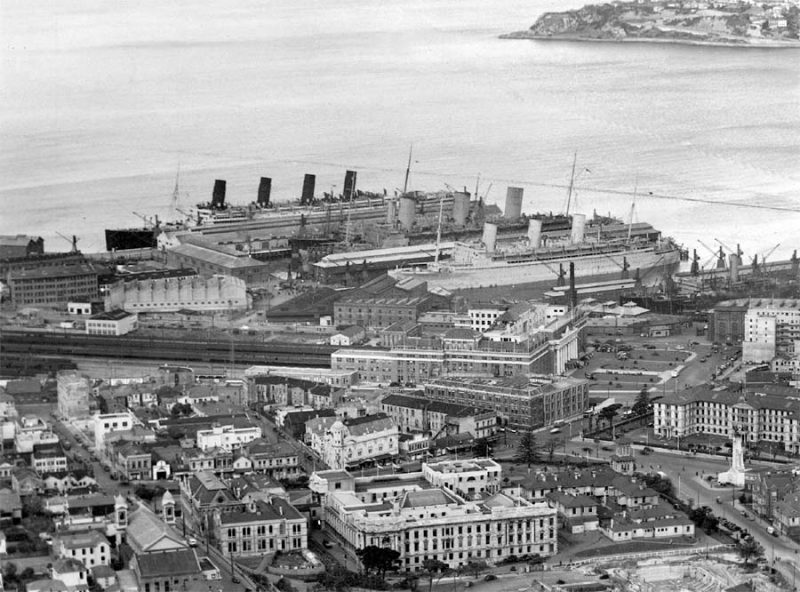
Wellington Harbour Board
Wellington Harbour Board was constituted on 1st January 1880 by an Act of Parliament by local shipowners, and the Wellington City, Hutt County, and Wairarapa County Councils, and the Wellington Chamber of Commerce, with the Mayor of Wellington as a direct government appointment. There have been forty elected Members and Chairmen of the Harbour Board since its formation, drawn from both shipowners and national and local Government appointments, the last was elected to the Board in 1980. The new Harbour Board was given the right to levy dues on goods passing through the port but had no assets, with the Harbour Master and Pilots as Government employees. The City Council owned Queen’s Wharf and its Bond Store, and a new wharf was reclaimed from the harbour and was owned by New Zealand Railways. The three storey Head Office and Bond Store on Queens Wharf were built of stone with tall windows on two floors, and had offices on the curved dark grey stone third floor. The Wharf Offices have four floors with one corner embellished with a tower, and today is opposite to a modern bronze coloured building on Custom House Quay, the latter building has been built on the site of the General Post Office of New Zealand.
The Lambton Quay of 1930 extended over two and one half miles of quays and storage sheds, and the Wellington Harbour Board required a large floating dock at this time to repair the many large liners calling at the port from Europe and the Australasia region. The Jubilee Floating Dock of 17,000 tons lifting capacity was designed by Clark and Standfield of Westminster, and ordered on the 50th anniversary of the Harbour Board from the Wallsend yard of Swan, Hunter and Wigham Richardson Ltd. as Yard number 1463 for completion in July 1931. It was launched in three sections on 30th May, 1st June and 3rd June 1931 and riveted together before two twin funnelled steam tugs of L. Smit & Company of Rotterdam arrived in the Tyne to tow the dock to the other side of the world. The voyage of almost 14,000 nautical miles and five and one half months was via the Suez Canal, Malacca Strait, Torres Strait and the Tasman Sea with the dock arriving on 28th December 1931 at Wellington.
Mr. A.G.W. Barnett, General Manager of the Wellington Harbour Board, and Mr. C.J. Norwood (Chairman), and Mr. Eugene D. Cachemaille (Chief Engineer) welcomed the dock as a big improvement to port facilities, with the official lifting trial being on 2nd April 1932 using Ruahine 10,870/1909 on loan from the New Zealand Shipping Company. Ruahine was drawing 17.5 feet forward and 21.0 feet aft, with the dock sunk nearly forty feet to give ample clearance over the keel blocks. Ruahine was decked overall with flags for the occasion, with the pumping out of the dock begun at slow speed, as soon as the ship had been centred over the keel blocks. The four pumps were capable of discharging over fifty tonnes of water per minute at normal working depth. They were speeded up as soon as the full length of the ship rested on the keel blocks. The propellers were soon visible, and the keel blocks then came into view, and the last few feet of raising the ship happened fairly rapidly. The dock controls and electro pneumatic valves led to the valve house on the starboard side of the dock, and together with the mechanical side shores, sliding bilge blocks and capstans all worked well. The dock was then opened to the public for inspection, visitors included Lord and Lady Bledisloe, the Governor General of New Zealand and his wife. The dock gave very satisfactory service repairing vessels of the Union Steamship Company of New Zealand, New Zealand Shipping Company, and the Federal Steam Navigation Company and an American oil tanker during its first year of operation.
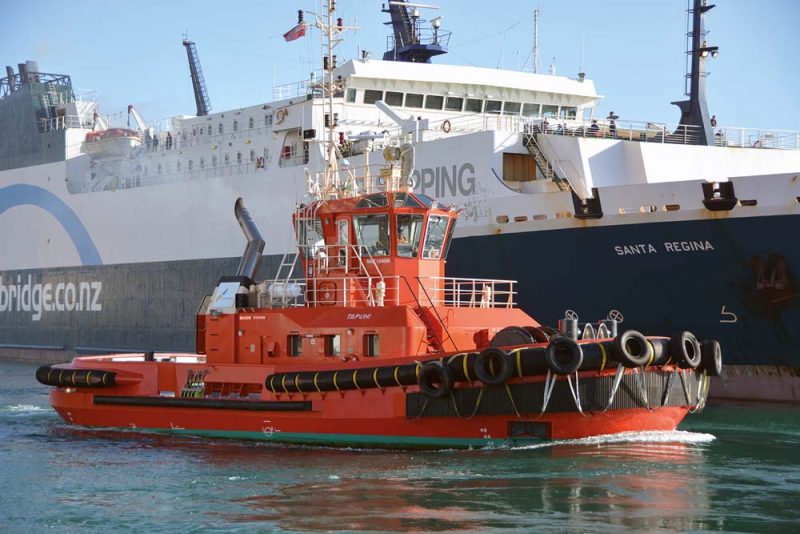
Harbour craft owned by the Wellington Harbour Board and CentrePort over the years have included the floating crane Hikitia 746/1926 from the Paisley yard of Fleming and Ferguson, the bucket dredger Whakarire 819/1903 from the Renfrew yard of Lobnitz & Co. Ltd., the ‘Saint’ class steam tug St. Fergus from Fleming and Ferguson renamed as Toia 423/1919, and the tugs Kerimoana 242/1938, Kupe 304/1971, Toia (2) 304/1972, Ngahue 243/1977, Tapuhi 457/1913 and Tiaki 457/1913, the latter pair being the current port tugs. In December 1988, the port tugs Kupe, Toia and Ngahue moved the Jubilee Dock a few hundred metres to Aotea Quay, the first time it had moved in 57 years. It was then sold to overseas buyers in Bangkok, but on the first leg of the voyage it broke in two and sank in two separate pieces over a period of six days in the first week of January 1989.


Wellington Harbour Board had to order the removal of the wreck of the almost new Union Steamship Company of New Zealand ferry Wahine of 8,944grt in April 1968. The ferry had been caught on 10th April by the most powerful storm yet experienced at Wellington when she arrived off the mouth of the harbour at 0630 hours. Winds gusting at 130 mph forced her onto the rocks at Barretts Head, but the tide lifted her off and both anchors were dropped. There were 727 passengers, 65 cars, mail and cargo from Lyttelton onboard, but as she passed through Chaffers Passage she lost her main power, and the company steam tug Tapuhi 232/45 had her line to the ferry broken by the wind, with no chance of putting another line onboard. Wahine listed heavily to port at 1330 hours off Seatoun but her starboard boats brought most of her passengers to the Seatoun shore, but many passengers in lifejackets were swept across the harbour to land in the surf of the rocky coast, killing 51 people including four crew members, with 680 rescued. Wahine capsized at 1420 hours on her port side in forty feet of water on the edge of the shipping channel. She had been in service for almost two years, and a memorial to the dead was unveiled at Seatoun Beach on 10th April 1993 on the 25th anniversary.
In October 1988, the business of the Port of Wellington was taken over by a conventional commercial enterprise named Port of Wellington Ltd., with the port then known as CentrePort Wellington. The Harbour Board’s own decisions had been overtaken by the central government’s restructuring of its own and local government activities. The Ports Reform Act of April 1988 set out the future ports policy of New Zealand, with the Wellington reorganisation taking place six months later. The substantial assets of the port accumulated over 108 years were divided between the district councils of Wellington, Hutt, Wairarapa and Manawatu, and the life of the Wellington Harbour Board ended on 31st October 1989 through the local government reforms of that year.
The Port Of Wellington Today
The Port of Wellington and its Lambton waterfront area has always been out of bounds to the residents of the city since its inception, and this is the policy of the present day port authority, now known as CentrePort Wellington. This has replaced the Wellington Harbour Board, but from the early 1970s the old traditional methods of unloading and loading general cargo with manual sling methods by dockers began to be replaced with container handling and a new container terminal. Today, the Port of Wellington and CentrePort handle cargo from both regional New Zealand and wider Australasian ports. They are strategically placed with access to both the east and west coast ports of North Island and South Island, and by national rail links from the Auckland area. Inter-island ferries of two companies run out of the port to Picton in northern South Island. The main facilities of the port comprise an International Cruise Terminal, a large Container Terminal, and new cold stores, container repair facilities, and specialised services to handle a very wide range of cargoes. There are also berths for the discharge and loading of bulk liquids, both chemical and petroleum, and also a bunkering berth.
Port of Wellington Container Terminal has two berths of 293 metres in length that can accommodate vessels of eleven metres in draft (Berth 1) and 10.7 metres in draft (Berth 2). There is no limit to the length of the ships using these two berths, and there is a container storage yard for 2,200 TEU of dry containers and 800 TEU of refrigerated containers. The container terminal is operated by Transport Systems 2000 Ltd., a joint venture between CentrePort and United Containers Ltd. The rail siding has a capacity for sixty rail wagons carrying 120 TEU of containers. There are facilities for stuffing and destuffing of containers, and washing and repair of containers. The Container Terminal also handles heavy lifts of yachts, project and break-bulk cargo, transformers and heavy machinery.
Refrigerated Cargo Handling Wharves monitor refrigerated cargo 24 hours a day to prevent deterioration to fruit, fish and meat cargoes, with this terminal served by two railway lines, each with sidings for eighteen rail wagons.

Port of Wellington Cruise Terminal is very busy over the six month cruise season from October to April, the southern hemisphere summer season. The cruise berths are across the road from the very large, circular Westpac sports ground. A full range of security services, border control inspections, entertainment and baggage handling for the 89 cruise ships arriving from many cruise lines during the 2017/18 summer season are provided. The local economy of Wellington is based on CentrePort and the Port of Wellington, as well as other industries including three electrical energy providers, Chorus Telecomms, Co-operative Bank, Kiwi Bank, Datacom IT Group, INfratil Infrastructure Investment, NZ Post, NZX Finance, Internet Auction Houses, Software companies and Wellington International Airport.
Cook Strait Ferries
New Zealand Government Railways/Interislander Ferries
The Union Steam Ship Company of New Zealand ran ferry services from Wellington to Lyttelton and later to Picton for many years from its inception in 1875, with the decision made by the company not to replace its twin funnelled conventional ferry Tamahine 1,989/1931 in 1957. A Cook Strait Transport Enquiry Commission was set up by the Government, and Prime Minister Sir Paul Nash gave the green light to a State owned rail ferry service, with the Union Steam Ship Company managing the first ship, the diesel electric Aramoana of 4,160grt and delivered by the William Denny yard at Dumbarton in 1962. She had accommodation for 800 passengers, thirty rail wagons and sixty cars, all loaded through the stern door. She had a service speed of seventeen knots from English Electric diesel electric engines built at Rugby.
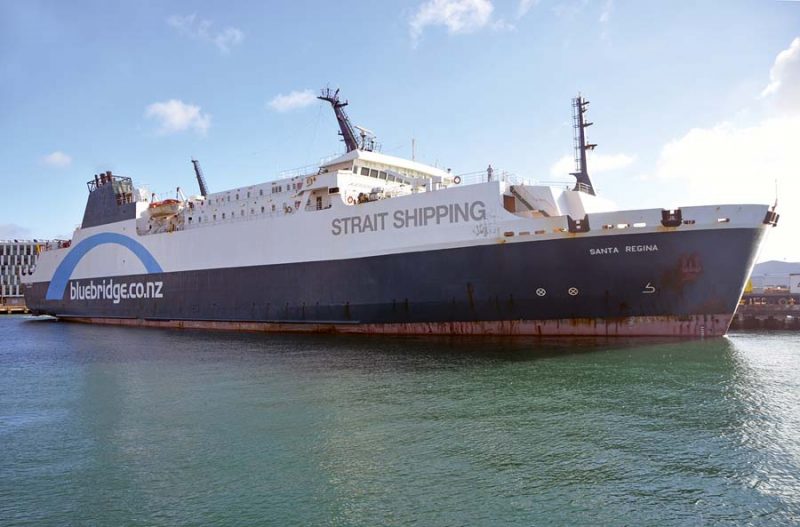
A sister to Aramoana was delivered in 1966 by the Vickers Armstrong Ltd. Naval Yard on the Tyne as the diesel electric Aranui of 4,542 grt with the same capacity and draft of fifteen feet as her sister. Upper Clyde Shipbuilders Ltd. at Clydebank delivered a similar stern loading third sister in 1972 as Arahanga, but powered instead by Crossley Pielstick engines. A larger rail ferry was ordered at this time for delivery in 1974 from the Nantes yard of Dubigeon Normandie and named Aratika of 9,035grt on dimensions of length 127.7 metres, moulded beam of 18.7 metres and draft of 5.09 metres with accommodation for 840 passengers, one hundred rail wagons and seventy cars. She made a grand total of 27,265 crossings of the Cook Strait from Wellington to Picton over a period of 25 years, and was sold in 1999 to MBRS Lines of the Philippines and renamed Virgin Mary until broken up ten years later in Italy.
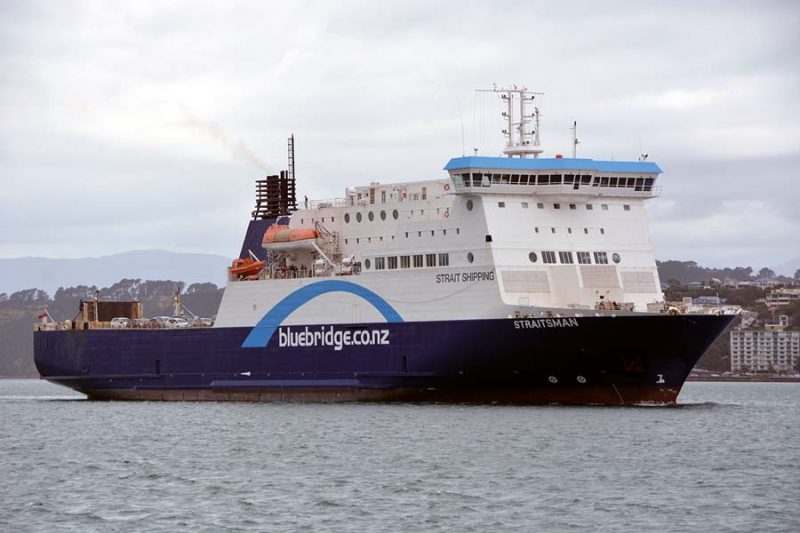
Arahura of 13,621grt was completed for New Zealand Government Railways in 1983 by the Aalborg Vaerft yard in Denmark on dimensions of length 148.3 metres, moulded beam of 20.5 metres and draft of 5.47 metres, and replaced both Aramoana and Aranui. She had accommodation for 550 passengers, sixty rail wagons and 142 cars and had a crew of 65, with half replaced on a ‘week on, week off’ basis at the end of each week of service. She had an extensive rail deck, separate car deck, and good accommodation for passengers including an Observation Lounge, Queen Charlotte restaurant, cafe and bar, children’s play area, video arcade, food court, cinema and other facilities. She rescued the survivors from the sunken Russian cruise liner Mikhail Lermontov in 1986 after it had hit rocks in the beautiful fjord like passage up to Picton. She was given an extensive $NZ29 million refit in 2008 to increase both her rail wagon and car deck spaces. Arahura was retired from service in July 2015 after well over half a million crossings of Cook Strait, replaced by the chartered Stena Alegra renamed Kaiarahi, a Maori name meaning ‘to lead’ or ‘to guide’, and is the latest member of three modern, bright ferries of Interislander Ferries with spacious interiors, the other two being Aratere of 1999 and Kaitaki of 2005. Arahura arrived at Alang on 30th October 2015 and was beached for breaking up after a career of 32 years.
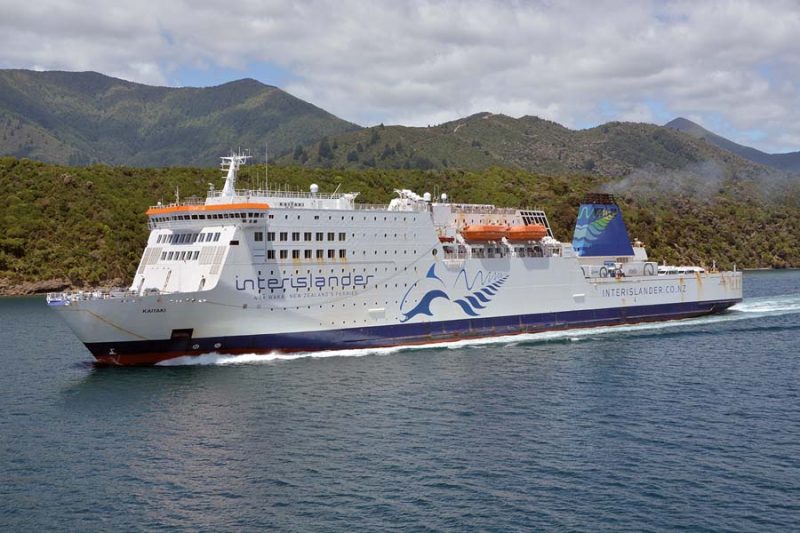
Aratere of 1999 and 17,816grt was completed for Tranz Rail, now Kiwi Rail and operating for Interislander Ferries, to replace Arahura. Aratere means ‘Quick Path’ in the Maori language and was completed by the Jose Barreras yard in Spain. She was lengthened in 2011 by the Sembawang yard in Singapore at a cost of $NZ52 million by the insertion of a new thirty metre mid-body to give dimensions of length 183.5 metres, moulded beam of 20.5 metres, and draft of 5.5 metres, and was given a new bow and stern. She has accommodation for 670 passengers, 32 rail wagons of 1,700 tonnes in loaded weight, and 230 cars or thirty trailers and trucks. She has six decks and makes six daily crossings of the Cook Strait at her service speed of 19.5 knots, and is powered by four Wartsila 8L32 diesel electric engines producing a total of 14,400 bhp at 750 rpm. She has a crew of 31 to attend to the needs of passengers enjoying the restaurants and fresh air on the Bridge Deck and Sun Deck. Aratere has suffered some engine problems and also lost one of her propellers in the Cook Strait in November 2013.
Kaitaki is a Ropax of 22,365grt and was launched on 1st January 1995 and completed on 25th May 1995 by the Van der Giessen yard at Krimpen in Holland as Isle of Innisfree for the Irish Ferries route between Holyhead and Dublin. She was chartered in 2002 by P. & O. Ferries and given a complete refit in Falmouth for English Channel service as Pride of Cherbourg. After the withdrawal of all P. & O. Ferries’ services from Portsmouth in 2004 except the service to Bilbao, she became Stena Challenger on the Karlskrona service to Gdynia for four months in 2005. She was sub-chartered to Interislander Ferries in June 2005 and arrived in Wellington after her long delivery voyage six weeks later. She was purchased outright by Kiwi Rail, the operator of Interislander Ferries, in 2017, with Kaitaki meaning ‘Challenger’ in the Maori language, and has accommodation for 1,650 passengers and 1,780 lane metres on her freight and car deck. She is the only one of three current Interislander Ferries fleet not to have a rail deck, and has a crew of sixty to attend to the needs of her passengers, including in the beautiful Club Lounge on Deck 7. She is powered by four Sulzer 8ZAL diesel engines of 23,040 bhp at 510 rpm to give a service speed of 20.5 knots, and has two bow thrusters for berthing and manoeuvring.
Strait Shipping/Bluebridge Ferries
On a day of good visibility, the coast of South Island can be clearly seen from Wellington. Picton on South Island clusters around a deep ravine at the head of Queen Charlotte Sound and has eight fully loaded freight and passenger ferry sailings arriving each day in summer from Wellington. This little town has excellent walking routes including the Queen Charlotte Trail to explore Queen Charlotte Sound and the neighbouring Marlborough Sound. It also has the Edwin Fox Maritime Museum to house the preserved third oldest in the world wooden ship, the former convict ship Edwin Fox. She was built of teak in Calcutta and launched in 1853 and had a chequered career carrying troops to the Crimean War, convicts to Australia, and immigrants to New Zealand. The vessel is beautifully preserved in its own indoor building and maritime museum, with many other maritime exhibits to explore.
It was only natural that privately owned competition on the Wellington to Picton route across the Cook Strait would arrive against the State owned service, and this was the brainchild of Jim Barker when he founded Strait Shipping in 1992. He needed a frequent service to move cattle between the North and South Islands for his customers, and found a small disused livestock carrier lying in a Tasmanian port that had been used on the Bass Strait service. This was the twin funnelled Straitsman of 1,481grt, completed in April 1972 by the North Queensland Engineering yard at the beautiful port of Cairns.
Straitsman could carry four hundred head of cattle and made her inaugural sailing for Strait Shipping on the Cook Strait in May 1992. She had a suffered a very bad sinking in the Yarra River at Melbourne on 23rd March 1974, when she capsized and sank on her side at 22 South Yarra Wharf after water entered through her stern door, which had been opened in readiness for berthing. She had altered from Full Ahead to Half Ahead, which caused the stern to squat at a time when her freeboard aft was just over one foot. The water on the vehicle deck caused a ‘free surface’ effect and consequent loss of stability. The hull lay across the Yarra river next to the ro-ro Dilkurra and just ahead of Port New Plymouth. Two lives were unfortunately lost, and she was raised nine weeks later. Straitsman had dimensions of length 62.6 metres, moulded beam of 11.8 metres, and draft of 3.8 metres, with a service speed of twelve knots from twin eight cylinder Blackstone diesel engines of 1,600 bhp. She served carrying livestock between Wellington, Picton and Nelson for ten years until sold in 2002 to Fijian owners and was renamed Sinu I Wasa.
The ropax ferry Suilven of 3,638grt entered service for Strait Shipping in 1995 after serving for twenty years in Scottish waters for Caledonian MacBrayne on the Ullapool to Stornoway route since completion in August 1974 by the Moss Rosenberg Verft A/S yard at Moss in Norway. She has bow and stern doors and ramps with accommodation for a small number of passengers and 122 cars and twenty trailers or lorries on her vehicle deck of lane length 250 metres. She ran from Wellington to Picton for seven years, making three round trips per week, and then transferred to the Wellington to Nelson service in late 2002. She has dimensions of length 86.5 metres, moulded beam of 16.0 metres, and draft of 4.96 metres, and was sold on for further service in April 2004.
The stern loading freight ro-ro Kent of 6,862grt was better known on the North Sea as Maersk Anglia and Maersk Kent sailing from Felixstowe until she was purchased by Strait Shipping in 2001 from Irish owners. She had been completed in 1977 by IHI at Tokyo as Admiral Caribe on dimensions of length 122.94 metres, moulded beam of 18.5 metres, and draft of 4.8 metres, and could carry 285 TEU of containers and ninety trailers on her freight deck of lane length 1,100 metres. She has a service speed of fifteen knots from twin twelve cylinder four stroke Pielstick diesel engines of 7,200 bhp, and was used on coastal freight runs from Wellington to Nelson, Napier and Lyttelton until sold in 2010.
Strait Shipping launched their Bluebridge Ferries passenger service across the Cook Strait in December 2002 using the twin screw ropax Santa Regina of 13,358grt. She was completed in 1985 by Societe Nouvelle Ateliers et Chantiers du Havre (ACH) with three decks for 400 passengers, fifty cars, and 110 trailers or lorries on a lane length of 1,300 metres. She has dimensions of length 136.0 metres, moulded beam of 22.6 metres, and depth of 19.3 metres with a draft of 6.4 metres, and a service speed of 18.5 knots from twin nine cylinder four stroke Pielstick diesels of 10,400 bhp. After thirteen years of Bluebridge service she was retired in June 2015.
The ropax Monte Stello of 11,630grt joined Bluebridge Ferries in 2006 with accommodation for 110 passengers and a freight deck of lane length 970 metres. She had been completed in 1979 by Societe Nouvelle Ateliers et Chantiers du Havre (ACH) on dimensions of length 126.52 metres, moulded beam of 21.02 metres, and a draft of 5.85 metres, with a service speed of 19.5 knots from twin Pielstick diesel engines. She underwent considerable refurbishment and a refit before making her first crossing of the Cook Strait on 28th October 2006. She carried the letters ‘Strait Shipping’ in white on both sides of her blue hull, all subsequent company ropaxes carrying www.bluebridge in white on their blue hulls. She had been renamed Palanga in 1996 for Lisco Baltic service and DFDS Tor Line, before moving to Spain in 2004 for two years service with Trasmediterranea.
Monte Stello was sold in 2010 and replaced by the ropax Straitsman (2) of 13,906grt and completed in Holland in 2005 as Dueodde for service to Bornholm Island in the Baltic. She has accommodation for 400 passengers with a lane length 1,248 metres for 45 trailers or trucks and 150 cars. She had been designed in Denmark and was renamed Straitsman by the company in recognition of the sterling service of the pioneer vessel of the same name. She has dimensions of length 124.9 metres, moulded beam of 23.4 metres with a service speed of 18.8 knots (maximum of twenty knots) from twin MaK 9M32 diesel engines. She has a very comfortable contemporary Scandinavian lounge, with private cabins available as well as reclining seats, good cafe, reception area, family area, observation lounge and open access promenading space.
The latest Bluebridge Ferries ropax is Strait Feronia of 21,856grt, a ‘Visentini’ design type of length 186.0 metres better known as Mersey Viking for Norse Irish Ferries Irish Sea service along with her sister Lagan Viking. She was launched on 7th December 1996 and completed in July 1997 for the Liverpool to Belfast service, transferring to the Birkenhead to Dublin service in December 2005 as Dublin Viking. She was acquired by DFDS in August 2010 and renamed Dublin Seaways and ran until the service was closed five months later. She was then sold to Stena Line and renamed Stena Feronia and chartered for Algeciras to Tangiers and Kiel to Gothenburg service, before purchase by Strait Shipping in January 2015 and given her new name of Strait Feronia after a 45 day delivery voyage from Sweden to Wellington. She has accommodation for 370 passengers and a vehicle deck of lane length 2,150 metres, and a fast service speed of 21.5 knots from twin Wartsila 8R46 diesel engines to twin controllable pitch propellers. The Bluebridge Ferries service departs Wellington each day at 0230, 0800, 1330 and 2045 hours from their terminal opposite the main railway station, and from Picton at 0800, 1400 and 1900 hours. The Interislander Ferries terminal is one kilometre north of the railway station, with sailings from Wellington at 0330, 0900, 1445, 1700 and 2030 hours, with return sailings from Picton at 0905, 1045, 1400, 1845 and 2215 hours.
Postscript
Capt. Michael Pryce retired as Wellington Harbour Master in July 2017 after 28 years of being the man in charge of shipping in Wellington Harbour. He was often seen at the signal station in the high Wellington Harbour Radio (Beacon Hill) lookout point with a good view of the harbour. The signal station is manned on a 24 hour basis and receives all communications from vessels. The signal station is also the afterhours contact for the Duty Pilot (drawn from a Chief Pilot and seven other pilots), who receive ETA messages from ships four hours before arrival with a final confirmation one hour before arrival.
Mike had served the first half of his long career as a tanker master with Shell, and then took up his important appointment at Wellington in 1989. He very much loved the busy movement of vessels in the harbour, including the fast catamarans of the harbour passenger service of East by West Ferries running from Queen’s Wharf at Wellington to the small communities at Hutt (Petone), Matiu/Somes Island, Days Bay, Eastbourne and Seatoun, with sixteen return crossings each day. Mike had responsibility for responding to marine oil spills along the west coast of lower North Island as far north as Otaki, and on the east coast as far north as Castlepoint in Wairarapa. He was aboard abandoned fishing trawlers on several occasions that were towed out of Wellington harbour by the tug Toia from Miramar Wharf for scuttling in the Cook Strait. Matiu means ‘peace’ in Maori and was settled by their great chief Kupe and his descendants, until they were deposed by British settlers in the 1830s, the island was then named after Joseph Somes, Deputy Governor General of New Zealand.
The Kaikoura earthquake of November 2016 severely affected the Port of Wellington, damaging the twin CentrePort container cranes and putting them out of action for ten months. September 2017 saw the return of container ships of the Maersk Line Northern Star service, as well as calls by MSC, NZS/KIX, and the ANL Transtaz service. The liquefaction effects on the container wharf by the earthquake needed a $NZ28 million project to strengthen it. This included 185 steel piles of length forty metres, 644 gravel columns, and one thousand tonnes of steel reinforcement, with demolition of other earthquake prone port buildings also taken place.
The CentrePort Head Office is at CentrePort House on Hinemoa Street in Wellington, with the port having the great advantage of a natural deep water harbour close to the productive areas of North Island. Trade across the Tasman Sea to Australia, and north along the line of the Kermadec deep trench to Fiji, Tonga and other South Pacific islands is very important to the port. The Cook Strait ferries and freight traffic to the South Island ports of Nelson, Westport, Greymouth, Lyttelton, and the ports of the Otago peninsula make the port a very busy and bustling area.

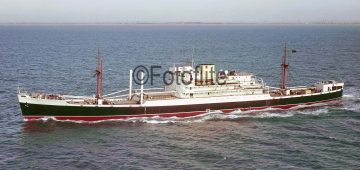



Comments
Sorry, comments are closed for this item